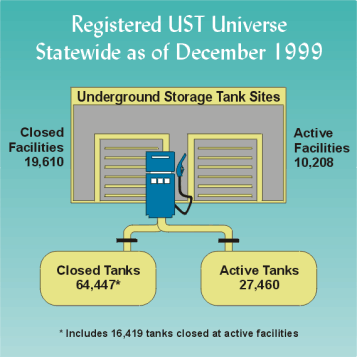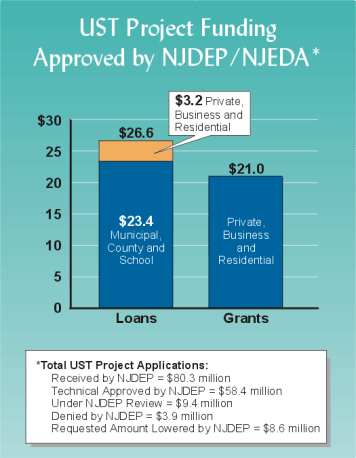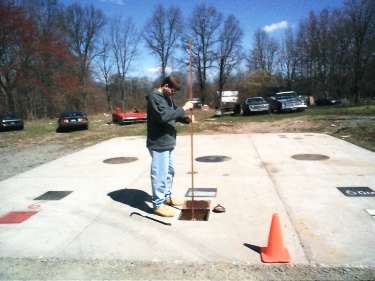|
I. Introduction
Underground Storage Tank Upgrades Protect Ground Water Resources and Potable WellsThousands of non-compliant underground storage tank systems were upgraded or closed in 1999, protecting the state's ground water resources and potable wells used by residents from potential contamination. Numerous parties performing this work benefited from $30 million in grants and loans disbursed in 1999 by the state from Corporate Business Tax monies dedicated for such actions. Furthermore, NJDEP's Site Remediation Program took enforcement actions against several tank owners who failed to achieve compliance with new state and federal upgrade regulations, identifying the parties through the Department's tank registration process. More than 10,000 underground storage tanks not in compliance with state and federal regulations were reported closed by facilities statewide during 1999. The removal of these old tanks for replacement with upgraded models or their discontinued use clearly improved the environmental conditions in every county of the state. Removing potential sources of ground water and drinking water contamination protects these valuable water resources from the hazardous substances found in gasoline and other stored products. Statewide, the number of active facilities decreased in 1999 from 11,367 to 10,208, a 10 percent reduction. The status of the registered underground storage tank universe is noted in Figure 1 as of December 1999. The number of active tanks declined from 31,804 to 27,460, a 13.5 percent drop. A large number of tanks were replaced while others were closed. Some tank closings resulted in uncovering leaking tanks or associated piping. In December 1999, 3,172 cleanups were underway with NJDEP oversight across the state. Facilities unable to comply were putting the environment at risk and needed to close their tanks.
Since the passage of New Jersey's 1986 underground storage tank law, more than 60,000 tanks have been permanently closed thus reducing the threat of ground water contamination from this large number of unmonitored, substandard underground storage locations. More than 10,000 facilities reporting discharges have been cleaned up. Schools, municipalities, counties, businesses and residents shared the benefits of $30 million in grants and loans to help meet the underground storage tank upgrade requirements from NJDEP's Site Remediation Program and the New Jersey Economic Development Authority in 1999. Figure 2 shows the cumulative amount of loans and grants provided by NJDEP and EDA since the monies became available in 1997 through a voter-approved dedication of Corporate Business Tax funds for such activities. Site Remediation Program staff initially review applications for technical merit and appropriate cost estimates for remedial work proposed. The Economic Development Authority reviews an applicant's financial status and issues funds when approved.
In 1999, the Legislature enacted a cap waiver on funds available for private parties conducting upgrades that encounter contamination during the process. This issue came to the Department's attention when owners and operators that received funding from the underground storage tank fund for removal and replacement of their tank systems discovered leaks and required additional funds to complete the work. While monies existed in the overall fund, only a set amount was earmarked for private parties upgrading tank systems and removing contamination. The Department and EDA could only disburse a set amount of funds for upgrade and remedial activities each year as guided by statute. Because additional funding for such work was capped many upgrade efforts were halted. The Department worked with the Legislature to enact a one-year cap waiver that became effective April 1999. This allowed hundreds of owners and operators who were approved for grants and loans from the underground storage tank fund to amend their applications to account for possible contamination problems. Simply put, if owners or operators were in the process of replacing their tank systems and leaks were found, they could immediately seek relief from the fund to pay for the cleanups and not have to wait months or years until funds under strict cap limitations became available. The cap waiver action kept many owners and operators in business. Parties eligible for the funds under the cap waiver had to have submitted an initial application to the fund for basic upgrade work prior to January 1999. This action did not open up the fund to new applicants; it allowed owners and operators that already had met this criteria and received funds or were waiting for funds to apply for additional monies to address previously unknown contamination. NJDEP contacted all active loan and grant applicants about these new changes and worked with these parties to ensure that remediation monies would be available, if needed, avoiding lengthy closures of their operations. NJDEP has addressed this issue with Legislative leadership in 2000 to determine whether the limit can be waived for another year or removed entirely. Funds remain available for residents who need to perform cleanup actions at their residential properties when a home heating oil tank is found to be leaking. More than 600 owners and operators of regulated tanks signed Administrative Consent Orders with NJDEP by December 1998 to allow them to continue to operate while they took measures to upgrade their system. As of December 1999, more than 200 of these parties have completed the upgrade requirements and an additional 400 still have plans to complete the required work. NJDEP fined the owners and operators $2,000 a month allowing them to continue to operate and the penalty increased to $3,000 a month in 2000 until all requirements are met. Furthermore, these facilities must document each month that their tank systems are not leaking; otherwise, they must close immediately. Since all underground storage tank upgrade deadlines passed in December 1998, the Department's job of evaluating and insuring compliance was a primary focus throughout 1999 for the more than 10,000 locations that remained active. Overall, a high rate of compliance with the release detection, corrosion protection, spill prevention and overfill protection requirements by owners and operators of regulated systems was documented in 1999 by the Site Remediation Program. New measures to assure compliance included: requiring the submission of current tank(s) status during the permit renewal process; checking facilities that were out of compliance on the Department's database; an internet web site listing of "compliant" facilities; a Hunterdon County pilot program to inspect all facilities within its borders; and, targeted NJDEP inspections. Hunterdon County Pilot Inspection Program SuccessfulIn an attempt to have a strong field presence and supported with a $25,000 grant from USEPA, the Hunterdon County Health Department agreed to inspect all regulated underground storage tank sites in the county during a one-year period. NJDEP and USEPA provided training and database support and the county hired a dedicated person to fulfill this obligation.
Preliminary data indicates that the county health department conducted 186 inspections and issued 44 notices of violation. The county's efforts proved successful in resolving all but one notice of violation, which is pending referral to NJDEP for enforcement action. The ability of the county health department to document and resolve nearly 100 percent of the violations uncovered truly is the success story of this pilot project. The remaining active underground storage tank locations have demonstrated compliance with applicable upgrade, leak detection, and other UST requirements. The county's efforts and a planned two-year cycle of leak detection compliance and record keeping inspections will go a long way in protecting the valuable watersheds, including drinking water resources, of Hunterdon County. During the same time period, and funded with money from the County Environmental Health Act (CEHA), the counties of Union, Ocean, Gloucester and Hudson also participated in underground storage tank inspection training and committed to inspecting 316 locations. Data is pending from these counties as of April 2000. In State Fiscal Year 2000, the Department received a $50,000 USEPA grant to expand the newly created county underground storage tank inspection program. This grant combined with additional state and CEHA funds is expected to pay for inspection of more 950 underground storage tank locations; almost doubling the number of inspections planned from the prior year. Eleven counties have expressed an interest in participating, including Warren County which has agreed to inspect all regulated USTs within its borders. The success of these coordinated federal, state and county efforts have laid the foundation for a comprehensive field presence in 2000 that will result in inspections at numerous underground storage tank facilities in New Jersey. The Department recognizes in the next few years that the inspection of all regulated underground storage tank sites in New Jersey is an important goal. During the past 15 years, underground storage tank issues appeared on the legislative agenda for subject areas including upgrade requirements, loan and grant programs, deadlines, contractor certification, amnesty programs and federal consistency.
|
| To report an environmental
incident impacting NJ, call the Toll-Free 24-Hour Hotline |
||
Contact DEP | Privacy Notice | Legal Statement & Disclaimers | Accessibility Statement |
||
Site Remediation Program: SRP
Home | About SRP |
Search | Help Copyright © State of New Jersey, 1996- |



